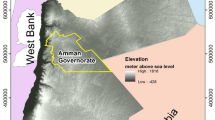Abstract
The Himalayan areas face frequent occurrence of water scarcity. There is a need for an assessment of water resources of the region. To meet the population’s water needs, existing water resources and new potential water bearing zones must be investigated. Due to high seasonal variability in river flows and very high sediment transport and monsoonal turbidity in river water in mountainous areas, indirect surface water abstraction from riverbank for drinking water production is becoming a cost-effective and sustainable alternative to the direct abstraction of river water and associated conventional treatment. However, the identification of suitable sites for indirect surface water abstraction is problematic due to limited vertical and horizontal extent of alluvial deposits. For an economical identification of potential sites, an approach combining various noninvasive techniques using geographical information system (GIS), remote sensing and groundwater flow modeling (PMWin) software has been suggested for a study area comprising a 100-km-long mountainous stretch of the Alaknanda River in the state of Uttarakhand, India, having a catchment area of 10,577 km2.
Access this chapter
Tax calculation will be finalised at checkout
Purchases are for personal use only
Similar content being viewed by others
References
Census of India (2011) Office of the Registrar General and Census Commissioner, India, Ministry of Home Affairs, Government of India. Source: http://censusindia.gov.in and http://www.citypopulation.de/php/india-uttarakhand.php. Accessed 1 Mar 2020
Climate data: www.worldweatheronline.com.Accessed 1 Mar 2020
CGWB, (2012). Bhu-JAl News. Volume 27, No. 1 to 4, Jan to Dec 2012 www.cgwb.gov.in/INCGW/GC%20Negi%20Report.pdf. Accessed 4 Apr 2020
Detail Project report (1994) Srinagar Dam. Source: library IIT Roorkee
Economic Survey of Delhi (2005–2006) Water supply and sewerage. Available. http://delhiplanning.nic.in/Economic%20Survey/ES%202005-06/Chpt/13.pdf
Ground Water Prospects Map (2008) Uttarakhand Space Application Centre. NRSC (ISRO), Department of space, Government of India
Kumar M, Rajwar GS (2011) Grain production of wheat (Triticum aestivum L.) and rice (Oryza sativa L.) at different altitudes in Garhwal Himalaya, India. Agricultura (Slovenia) 8(1):11–16
Mahajan A, Gupta RD (2009) Integrated nutrient management (INM) in a sustainable rice-wheat cropping system. Springer Science & Business Media
Patro ER, Voltz TJ, Kumar A, Grischek T (2020) Micro-hydropower in drinking water gravity pipelines: a case study in Uttarakhand, India. ISH J Hydraulic Eng 26(3):332–342. https://doi.org/10.1080/09715010.2018.1492977
Patro ER, De Michele C, Avanzi F (2018) Future perspectives of run-of-the-river hydropower and the impact of glaciers’ shrinkage: the case of Italian Alps. Appl Energy 231:699–713
Patwal PS (2015) Integrated water resources management of a river stretch using GIS & ground water flow modeling. M.Tech Thesis, Indian Institute of Technology Roorkee (IITR), India
Ronghang M, Kumar P, Mehrotra I (2011) Water quality investigations at four new RBF sites in Uttarakhand. CCRBF-HTWD internal report for phase 2 of DST-WTI project—Development of River Bank Filtration in Hill Regions for Sustainable Solution for Quality and Quantity Problems of Drinking Water in Uttarakhand
Sandhu C, Grischek T, Kumar P, Ray C (2011) Potential for riverbank filtration in India. Clean Technol Environ Policy 13(2):295–316
Sati VP (2008) Natural resource management and food security in the Alaknanda Basin of Garhwal Himalaya, India. ENVIS Bull: Himalayan Ecol 16(2):1–11
UJS (2013) Development of river bank filtration in hill regions for sustainable solutions for quality and quantity problems of drinking water in Uttarakhand. R&D project, internal report, Uttarakhand Jal Sansthan
Author information
Authors and Affiliations
Corresponding author
Editor information
Editors and Affiliations
Rights and permissions
Copyright information
© 2023 The Author(s), under exclusive license to Springer Nature Switzerland AG
About this chapter
Cite this chapter
Patwal, P.S., Patro, E.R., Islam, S.U. (2023). Water Resource Estimation and Management: Case Study of the Alaknanda River Basin. In: Shukla, P., Singh, P., Singh, R.M. (eds) Environmental Processes and Management. Water Science and Technology Library, vol 120. Springer, Cham. https://doi.org/10.1007/978-3-031-20208-7_14
Download citation
DOI: https://doi.org/10.1007/978-3-031-20208-7_14
Published:
Publisher Name: Springer, Cham
Print ISBN: 978-3-031-20207-0
Online ISBN: 978-3-031-20208-7
eBook Packages: Earth and Environmental ScienceEarth and Environmental Science (R0)




